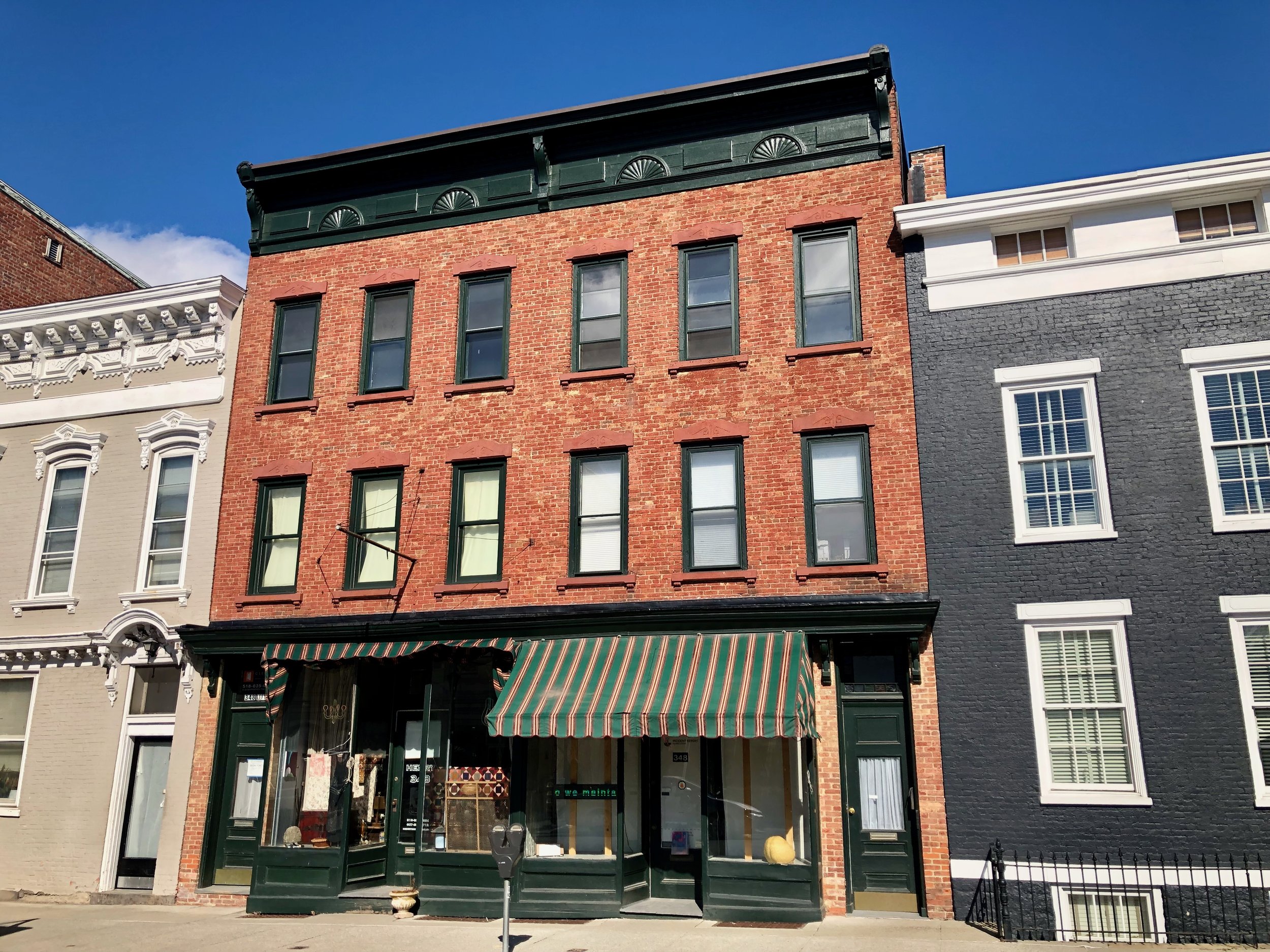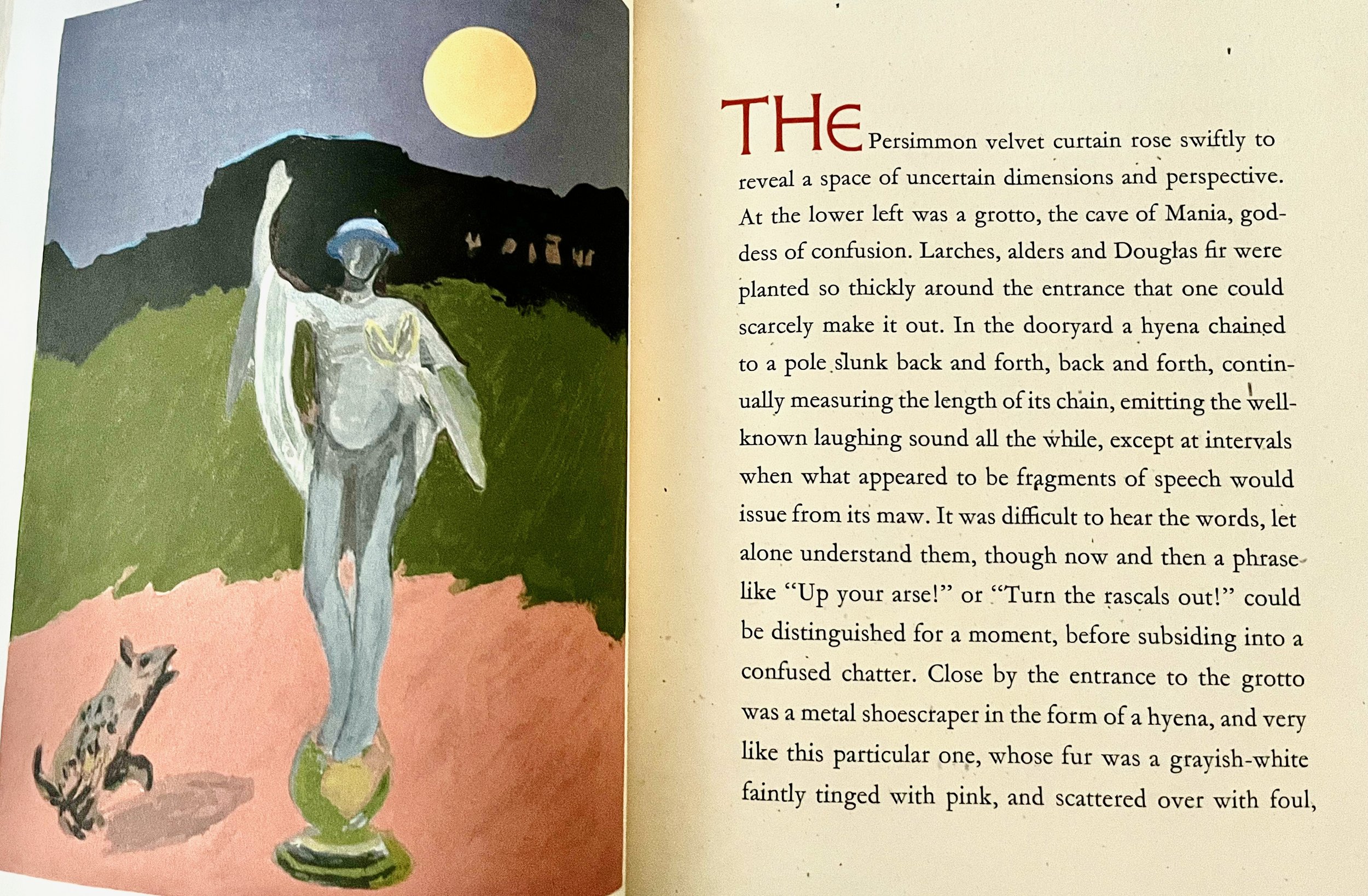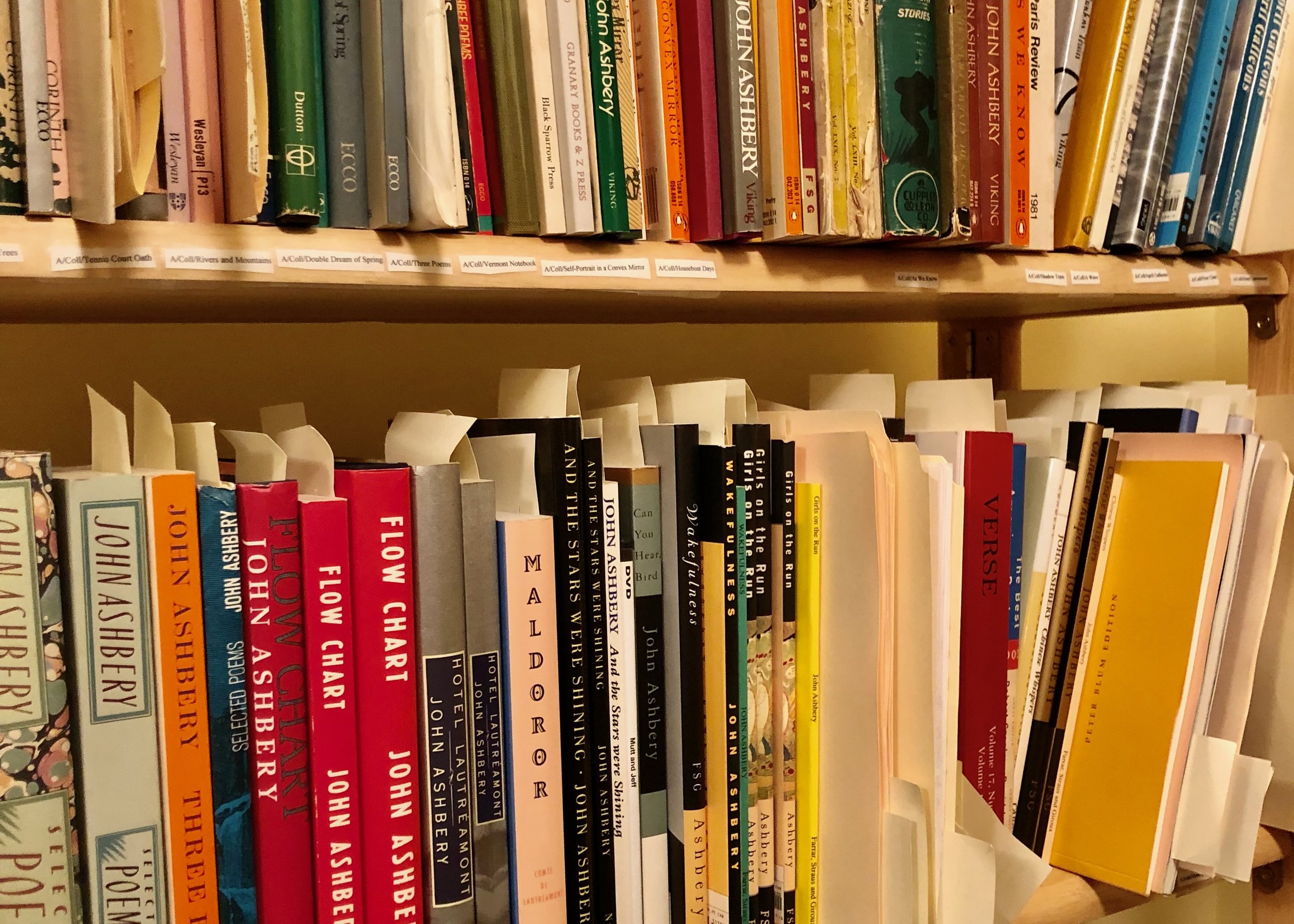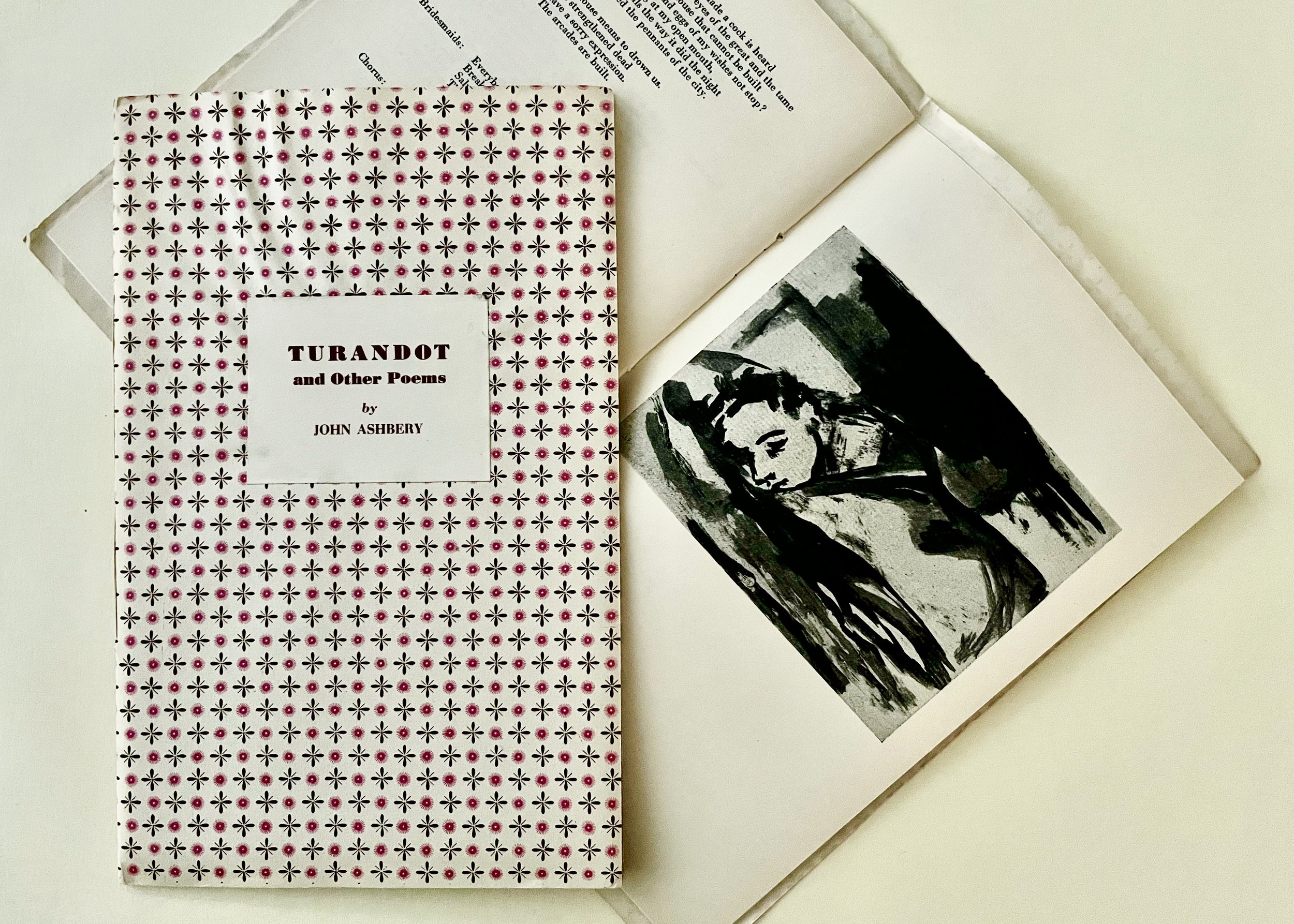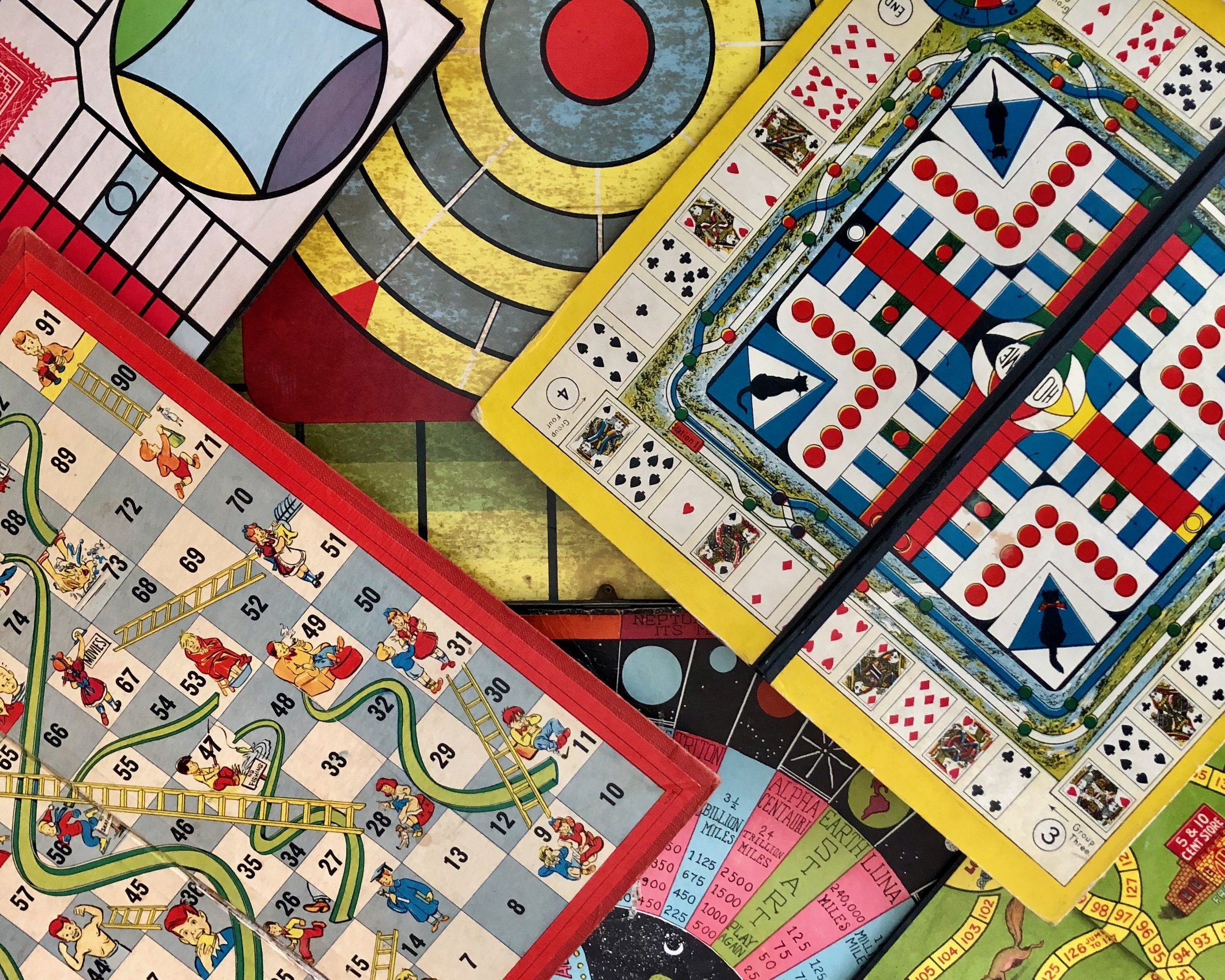Ashbery Resource Center
The Ashbery Resource Center (ARC)—the library and special collections of The Flow Chart Foundation—welcomes scholars, artists, writers, and readers, toward deepening scholarship, providing artistic inspiration, and offering generative opportunities to engage with the multifaceted work of John Ashbery and the wider artistic legacy of the New York School.
The ARC acquires, preserves, and provides access to a range of primary materials from Ashbery's personal collection of visual art, books, objects, ephemera, and belongings, as well as a range of materials documenting Ashbery’s work and artistic influence. The ARC’s holdings represent the exploration of interrelationships of various art forms, offering unique opportunities for innovative scholarship and creative inspiration, and promoting new possibilities for discovery, thought, and connection as guided by the legacy of Ashbery's work.
The Ashbery Resource Center is located at 348 Warren Street, in Hudson, NY 12534, and may be visited by appointment only. To schedule a time visit, email: arc@flowchartfoundation.org.
Note that we can only accommodate individual visits at this time.
A searchable online catalog of holdings can be found below, as well as a variety of online resources related to Ashbery’s life and work available to all.
Poet/translator/art-writer/artist John Ashbery and his husband David Kermani (Ashbery bibliographer and Executor of the Ashbery Estate) established The Flow Chart Foundation, named for Ashbery’s book-length poem Flow Chart, in 1998. The initial project was established to encourage the study of interrelationships among various art forms, as well as to facilitate awareness of the roles that an artist's environment can play in the creative process. The focus was primarily on an exploration of these issues as they are revealed through the various environments that Ashbery created, and through the creation of the ARC.
Special collections and library items from the ARC have been used for research, exhibition, inspiration, and interpretation. Specific projects that have utilized the ARC include Karin Rothman’s biography of John Ashbery, The Songs We Know Best: John Ashbery's Early Life (Farrar, Straus and Giroux, 2021); Jeffrey Lependorf’s edited collection Something Close to Music Late Art Writings, Poems, and Playlists (David Zwirner Books, 2022); and Emily Skillings’ edited collection Parallel Movement of the Hands: five unfinished longer works by John Ashbery (Ecco, 2021). Artist Richard Kraft has been using images of Ashbery’s collage materials from the collection to create original works.
The ARC is the primary focus of The Flow Chart Foundation’s mission. We invite museums, libraries, academic institutions, and others to consider including objects from our collections in exhibitions and to request loans from the ARC. We encourage scholars, artists, and readers of Ashbery to engage with the ARC’s primary and secondary sources, toward creating new scholarship and creative work, while also bringing a new generation of readers into Ashbery’s world. The ARC makes its collections available to all researchers on equal terms. Our holdings are intended to support scholarly research and creative inspiration and we encourage anyone interested in poetry, the interrelationships of various art forms, or the New York School, to conduct research in our holdings. We welcome scholars, historians, teachers and students at all levels, artists, writers, documentarians, and any other curious parties. Researchers may visit by appointment, or search our annotated online catalog, which serves as a list of our holdings and also functions as a de facto provisional bibliography of Ashbery’s work, and as a step towards establishing the definitive canon. In addition, the wide range of resources identified and categorized in this way helps to define a context for Ashbery’s work and also is made more accessible to researchers and enthusiasts involved with the New York School and the general cultural milieu of the period.
Online Catalog
This annotated, searchable catalogue provides an inventory of the archive maintained at the Ashbery Resource Center, a project originally developed by The Flow Chart Foundation on behalf of Bard College. The archive contains growing collections of material by, about, and relating to John Ashbery and his work; the annotated citations that comprise this catalogue serve to document the archive’s holdings of items in various formats and media, published and unpublished, including poetry, fiction, critical prose, translations, interviews, and collaborations, as well as visual art, musical compositions, films, plays, artifacts, and ephemera.
Although the project is ongoing, the catalogue functions as a de facto provisional bibliography of Ashbery’s work, and as a step towards establishing the definitive canon. In addition, the wide range of resources identified and categorized in this way helps to define a context for Ashbery’s work and also is made more accessible to researchers and enthusiasts involved with the New York School and the general cultural milieu of the period.
The catalogue has been designed to accommodate both casual browsing of the detailed citations and comprehensive searches of the entire database. Browsing within the catalogue may facilitate serendipitous discoveries among an abundance of factual and speculative information: publication data; identification of source material; anecdotal and contextual backgrounds; subjects covered in interviews, essays, and writings about art; and links to related websites or multimedia files. Searching the database by specific, even multiple variables will yield results tailored to focused inquiries. Either method of use will suggest insights into possible relationships between Ashbery’s work and the multiple contexts within which it exists.
Because this catalogue is an ongoing work-in-progress, users should note that citations are added, corrected and updated frequently (please bring errors and omissions to our attention). Further, due to the idiosyncratic nature of both this catalogue and the work it documents, users should consult the Reference Guide to the Bibliographic Codes and the general search tips on searching the catalogue to get their bearings. Those doing scholarly research may wish to study the complete Instruction Manual for various cataloging details. Finally, users are cautioned that all inferences in the citations about possible relationships among various items and materials are merely suggestions that may lead to productive avenues of inquiry; conclusions may be drawn at your own risk. Nevertheless, the compilers hope that the catalogue will prove interesting and useful, even in its current incomplete and (deliberately) inconclusive state.
Predicated on David Kermani's extensively annotated bibliography of Ashbery works through 1976, the Ashbery Resource has worked (and continue to work) on providing a comprehensive reference site for Ashbery scholars and enthusiasts who may search the catalogue of the physical Ashbery Resource Center by clicking the SEARCH THE CATALOG button below.
The online catalog allows both basic and advanced searches. General Search tips can be found here; the complete manual for advanced searching and catalog methodology can be found here.
Information about John Ashbery
The information presented here provides a general overview of the highlights of John Ashbery's career, as well as providing biographical, chronological, and critical contexts for evaluating Ashbery's work. Although not comprehensive, the material below offers quick reference and provides answers to many of the most frequently asked questions.
Features about Ashbery
A small gathering of miscellaneous online materials unlikely to be found elsewhere that may be of interest to Ashbery scholars and enthusiasts...
Ashbery and Sarah Rothenberg: A Conversation on Music and Literature
John Ashbery Makes a Collage by Michael Thomas Davis
Juniper from a seminar by Dara Wier
Men With a Pair of Scissors: Joe Brainard and John Ashbery by Dr. Rona Cran (video talk)
Mirroring by Alterity by George Quasha (on Ashbery reading)
Annotated Guide to Ashbery’s poem “The Dong With a Luminous Nose”
A Note on the Game Board “Shooting Gallery,” Ashbery’s Game Board Collage “Circus Friends,” and My Collage “Wynandotte Sharing Gallery” by Rachel Blau DuPlessis
Readings by Ashbery of his Poems
A significant number of recordings gathered by the Ashbery Resource Center can be streamed through PennSound. A small selection follows:
Numerous discussions about Ashbery’s work, conversations with him, and readings by others of his poetry can also be found at PennSound. The Flow Chart Foundation is grateful to PennSound for digitizing recordings from the Ashbery Resource Center and making them available.
John Lithgow presents John Ashbery with the National Book Foundation’s 2011 Lifetime Achievement Award, introduced by Ann Lauterbach. He uses his speech to discuss “difficulty” vs. “accessibility.”
White Roses
The worst side of it all—
The White Sunlight not the polished floor—
Pressed into service,
And then the window closed
And the night ends and begins again.
Her face goes green, her eyes are green,
In the dark corner playing “The Stars and Stripes Forever,” I try to describe for you,
But you will not listen, you are like the swan.
No stars are there,
No stripes,
But a blind man’s cane poking, however clumsily, into the inmost corners of the house.
Nothing can be harmed! Night and day are beginning again!
So put away the book,
The flowers you were keeping to give someone:
Only the white, tremendous foam of the street has any importance,
The new white flowers that are beginning to shoot up about now.
— from The Tennis Court Oath (© 1962, 1985, 1987, 1997, 2008 Estate of John Ashbery. All rights reserved. Used by arrangement with Georges Borchardt, Inc.)
Uptick
We were sitting there, and
I made a joke about how
it doesn’t dovetail: time,
one minute running out
faster then the one in front
it catches up to.
That way, I said,
there can be no waste,
Waste is virtually eliminated.
To come back for a few hours to
the present subject, a painting,
looking like it was seen,
half turning around, slightly apprehensive,
but it has to pay attention
to what’s up ahead: a vision.
There poetry dissolves in
brilliant moisture and reads us
to us.
A faint notion. Too many words,
but precious.
— from Planisphere (© 2009 Estate of John Ashbery. All rights reserved. Used by arrangement with Georges Borchardt, Inc).


